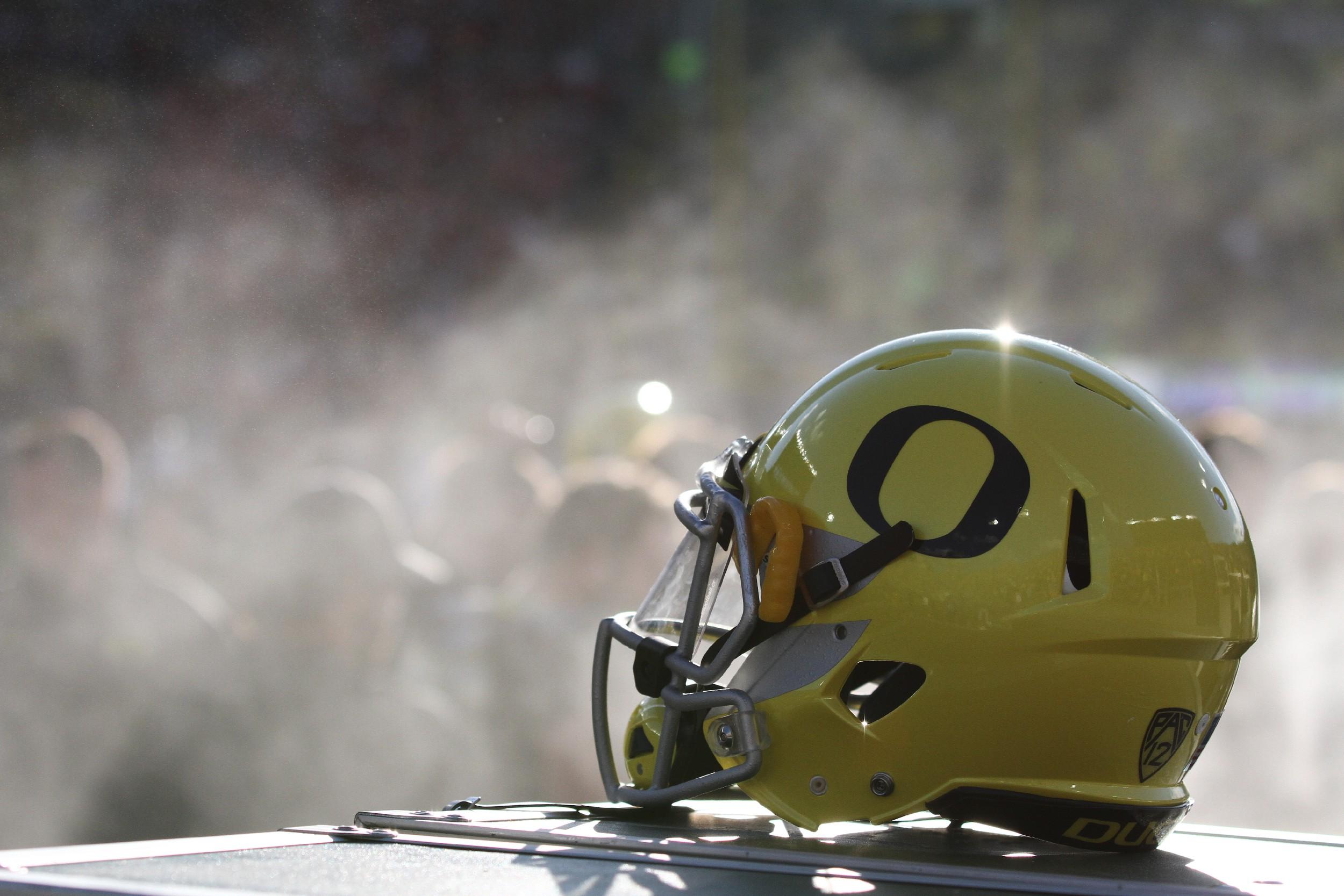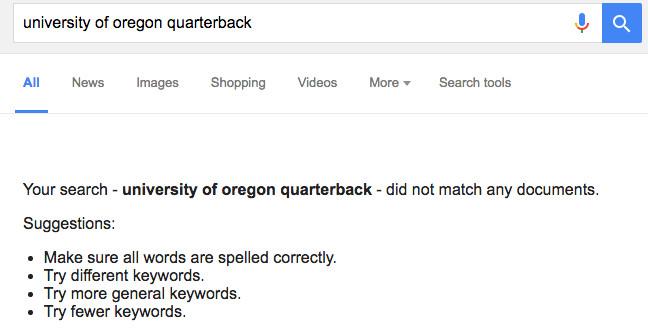
Oregon has a quarterback problem. It’s not plagued by bad quarterbacks. Hardly. But with one very notable exception in the past 10 years, the Ducks haven’t had a QB who has held the starting role for more than two seasons. Whether due to injury, graduation, transfer, or even just a crippling need 4 weed, a four-year — hell, even a three-year — quarterback is a myth to University of Oregon football.
This is the actual result I got after Googling “university of oregon quarterback”:

This is likely a result of bad search terms — happily (so, so happily for me, a UO graduate and unapologetically biased fan) “oregon duck football quarterback” yielded many, many pages of actual results. But the visual is apt: Aside from Marcus Mariota, Oregon Duck football has lingered in a state of quarterback angst. The high volume of QB turnover almost never results in terrible seasons, but the always changing names and varying play styles can mess with a fan’s psyche. (There’s also a sense of Oregon football PTSD that at a critical time, our QB is going to get hurt.) Bottom line: Don’t get too attached because no one will be around for very long. Never get comfortable.
Such was the case last year with Vernon Adams Jr. The transfer from Eastern Washington University was able to step in for Mariota shockingly well (thank god for math tutors!). So what about this year? Fifth-year senior Dakota Prukop, a transfer from Montana State, will likely start at quarterback this year, though Travis Jonsen and Terry Wilson could find playing time as the team tries to find its groove. But therein lies the problem — or rather, the source of fan anxiety: Quarterbacks define a team’s attitudes and set its style of play. The constant churn results in a feeling of unease. It’s an unsentimental process, getting attached to — even loving — a quarterback if he’s one and done. And who doesn’t want to love their quarterback?
“There isn’t any sport where one guy is so important,” said Andy McNamara, the assistant athletic director in athletic communications for UO football. “People are always interested in [the quarterback], and it’s justifiable.”
“I mean, you have a guy like Vernon, and the sky’s the limit … if he were healthy.”
“If he were healthy” — a refrain Oregon fans know well, especially concerning quarterbacks. Especially concerning quarterbacks during crucial games. Dennis Dixon, Darron Thomas (not in as crucial of a game, though it led to some controversy), Vernon — and yes, even Mariota — were all injured when it really mattered. McNamara remembers how this went down with Oregon’s Heisman winner. “We don’t release information on injuries, but he couldn’t run going into that game,” he said, referring to Mariota’s 2013 game against Stanford. “And then, when they figured out he can’t run, it was like, ‘Oh crap.’”
That sinking, pit-of-your-stomach, gut-twisting ache — Ducks fans know the feeling. I remember the last time I felt it: the 2016 Alamo Bowl. It wasn’t as if Adams’s injury had me worried about his status for next year — he’d be gone anyway — but it heightened the feeling. Fans were forced to wonder not just “What’s going to happen next year?” but also, “What’s going to happen next quarter?”
Oregon fans endure ribbing and side-eyed glances, as fans of other teams questioned the team’s new quarterback. “I dunno about him.” “How’s he gonna work with your offense?” “Can he run like Mariota?”
“Fans are not patient enough to sit through a rebuilding process,” McNamara said. “What’s unique about Oregon is the level we’re at in the national level, compared to the size of our stadium, our community. We have a smaller alumni base, a smaller community. You really have to fill seats.” He’s right: Eugene is not Los Angeles or Miami. It’s not even close to Seattle, but the Ducks are comparatively doing something right.
Another challenge inherent in the Oregon QB cycle: the other players. Returning members of the team have to adjust their game for as many as three potential starting quarterbacks, and a not terribly small handful of backups.
“You have to work a lot harder to develop that continuity with different guys,” said wide receiver Dwayne Stanford, who will have played with Mariota, Adams, and now likely Prukop (and various backups) come this season. “They have to learn how I move, how I like the ball on different routes, how I come out of different breaks. … I’ve had to work a lot more in the offseason to develop that chemistry with Marcus, Vernon, and [Jeff] Lockie, and now with Travis [Jonsen] and Dakota.”
Each of these quarterbacks can play in the Ducks’ traditional high-speed, no-huddle offense, but they’re very different players. It’s a lot to ask from a team, but it also encourages a versatility that beneficiaries of three- or four-year quarterbacks might not have gained.
Stanford said the constant change has another silver lining. “I’ve learned to be a lot better route runner, and learn the little nuances to running routes with different quarterbacks. I’ve become more crisp and exact — running at an exact depth, because if I’m with a new quarterback, I need to hit the mark exactly.”
Prukop, the fifth-year senior, will be another in-and-out QB for the Ducks, but what about the guys who didn’t get the job? “The three young guys behind Dakota …one of them is gonna be the guy,” McNamara said. “Unless something falls in our lap. Another Vernon or something.”
So the question remains: Why can’t Oregon, which has finished in the top 5 in the country in scoring every year since 2010, get a big-name young quarterback recruit? It would be nice to see a familiar face, year after year, to get used to a style of play, to not go into the first game of the season thinking “So, what’s this going to be like?” But maybe a better question is, “Does it matter if they don’t?”
“I guess that’s kind of our M.O.,” says McNamara. “We have these ‘problems,’ but we scrape our way out of them.”
Ten years, five (starting!) quarterbacks, 11 bowl games, and two national championship games later, the nervous ache before a new quarterback’s first game is becoming exhausting. Maybe that stomach-churning anxiety and angst is actually … excitement? In that case, Stanford may have described it best: “It’s been fun.”
An earlier version of this story misidentified the year the Oregon Ducks played in the Alamo Bowl. It was 2016, not 2015.